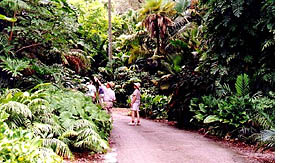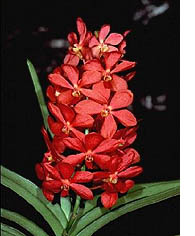A Walk in a Rainforest
By Chuck Hubbuch, former Director of Collections

Where would you look if you were walking in a rainforest? It is always a good idea to watch where you are placing your feet on unfamiliar terrain. In a rainforest, you also must watch where you place your hands, looking out for spines, stinging ants and other disagreeable things. The massive trunks of giant trees and the thick vines are hard to miss. Spots of color, sudden movements or strange sounds catch your attention. If you are looking for interesting plants and animals, you will move through the forest very slowly indeed. As you look around, you will see that as tropical forest is very different from a temperate forest. The floor of an old rainforest is often rather open and may not be very diverse. But I wonder, would you look up? Much of the rainforest's life is in the canopy. In fact, one quarter of a rainforest's plant species and over half of its living mass may be epiphytic plants. Around the world, about 28,000 species of epiphytes in about 80 plant families perch high up on branches, leaves and trunks of other plants.

Walking through the rainforest exhibit at Fairchild, you will see many changes brought about by Mike McLaughlin, Rainforest Managert, and his colleagues: new paths, new plants, and more. As you look around, do not forget to look up. Please stop when you do this so you do not fall over the tender roots of a venerable old oak or acquire the spines from one of our rare palms. Look carefully, it may take a moment to recognize the textures and separate the epiphytes from the background foliage. The green carpet of leaves on the branch tops is our native resurrection fern, Polypodium polypodioides. Way up there, on the high branch, do you see the rosettes of big leaves? They may be aroids, probably an anthurium species from the American tropics or a bird's nest fern from Australia or Asia. Over there, see the splashes of color? Those are orchids, maybe cattleyas, dendrobiums or vandas. Elsewhere, you will find a wide variety of other epiphytes: mosses, bromeliads, cacti, cyclanths, cycads and even a ginger, Hedychium hasseltii.
Since early June of 1998, Living Collections and Garden Landscapes staff and volunteers began removing aggressive vines and placing epiphytes in the trees of the rainforest canopy. Jennifer Wood, Chris Mayhew, Peter Brisbane and Audrey Chin have been especially noteworthy assistants. Craig Allen supplied many of the plants from the conservatory collections, along with valuable advice. Using ladders up to thirty feet tall and a hydraulic lift, we pulled the largest plants into place with ropes. While small plants can be attached with an outdoor glue (LiquidNails, in this case), ungalvanized steel wire (typically used in concrete work) was used to secure larger plants. Once they are in the trees, the epiphytes are watered by an irrigation system that runs along the tree tops. Mike McLaughlin has expanded this system to increase epiphyte growing areas.
Along with other planned changes for the rainforest, epiphytes will be added as opportunities permit. While we are labeling and mapping this new dimension in our landscape, we are very excited about the change in appearance. When you visit Fairchild's rainforest exhibit, keep an eye out - and up - for epiphytes.
Garden News, November 1998
Copyright © 2005 Fairchild Tropical Botanic Garden, 10901 Old Cutler Road,
Coral Gables, FL 33156 USA Phone: (305) 667-1651 Fax: (305) 661-8953